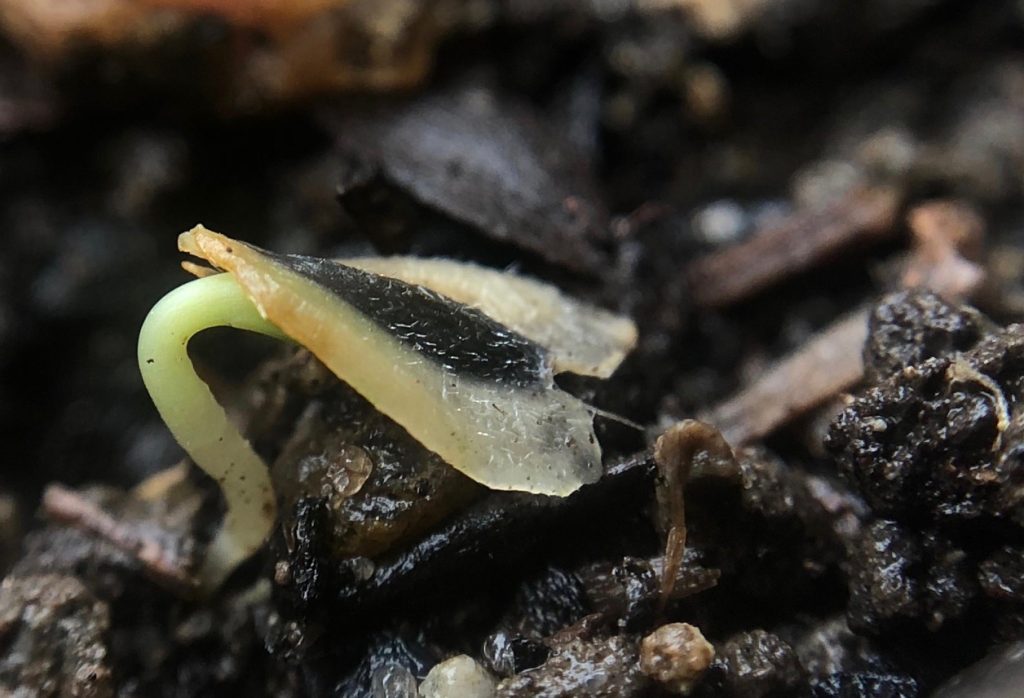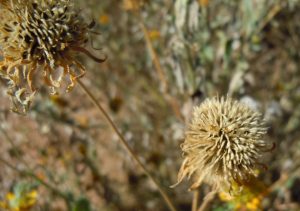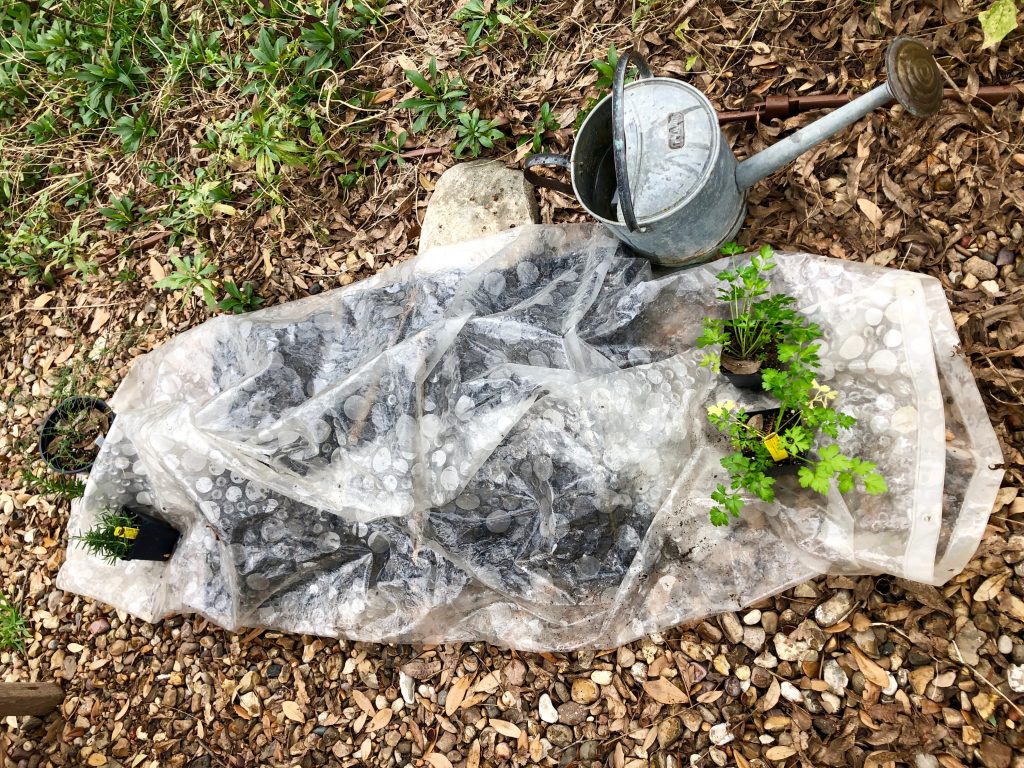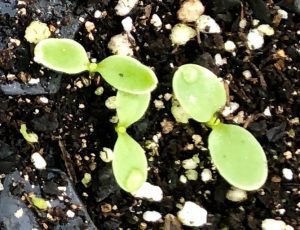Like many members of the sunflower family, Cowpen Daisy, Verbesina encelioides, germinates easily from seed. Sometimes called Butter Daisy or Golden Crownbeard, Cowpen Daisy is sometimes included in native seed mixes, but it’s almost impossible to find the seeds for sale on their own.

A sprouting Cowpen Daisy seed. Photo by Drake White
Native American Seed in Junction, Texas, stocks the reliable bloomer, offering a packet that will cover 20 square feet for $6. The good news is that once you sow San Antonio’s unofficial pollinator plant for 2019, you’ll likely never have to buy seeds or plants again. (Is this why nurseries don’t offer it?)

Cowpen daisy forms prolific seed heads. Photo by Monika Maeckle
Cowpen Daisy forms prolific seed heads after flowering. Each head contains about 75 seeds. They dry out in early winter and if not consumed by wildlife, drop to the ground and rest for a while. In early spring, they sprout a green carpet that’s easy to thin, if you choose.
George Cates, chief seed wrangler at Native American Seed, offers this advice: “Throw the seed on disturbed ground, walk away.” Truly, it’s that easy, according to Cates. For a general tutorial on growing natives from seed, check out How to Grow Native Seed, assembled by the professional seed purveyors.
General broadcasting of seed might not necessarily fit for a home garden. Many of us have particular plants in specific places and don’t want them crowded out. Or, we may not want the new Cowpen Daisy seedling to be overshadowed by more established foliage. Heavy mulching can also deter sprouting.
Thus, another way to get this plant in your yard is to plant the seeds in trays or pots and grow them to the seedling stage. Once they’re big enough to fight for sunshine on their own, transplant them to the yard.
That’s what I do. With the help of a makeshift growhouse fashioned from an old shower curtain, my Cowpen Daisies sprouted in about 10 days.

Makeshift growhouse: old shower curtain serves as seedlings’ winter blanket. Photo by Monika Maeckle
A plastic shower curtain served as their winter blanket. I laid it on the ground, loaded seed trays with potting soil and Cowpen Daisy seeds, taking care to tuck the seeds about a quarter-inch below the soil surface. A good watering followed. After propping several sticks around the edges of the trays to prevent the plastic shower curtain from from smothering the seeds and soil, I folded the shower curtain onto itself, and VOILA! A makeshift growhouse. Ugly, for sure. But it works.
The plants in the photos below were started as seeds on January 8. By February 12 they were thriving.
Drake White of the Nectar Bar in San Antonio uses a different method. She plants five Cowpen Daisy seeds per one-gallon pot. She tucks them in about a quarter-inch deep, waters regularly, and when they get about two inches tall, she cuts back two of the plants, leaving a set of three per one-gallon pot.
“That gives them plenty of room,” said White, who sells the plants to customers and installs them for clients at her pollinator landscaping business.
White waits for the plants to sprout their true leaves. True leaves are botany talk for the leaves that follow the baby leaves inherent in the seed.

True leaves are just becoming visible on this trio of Cowpen Daisy sprouts. See them in the middle? Photo by Monika Maeckle
Cowpen Daisies are dicots, that is, they have two seed leaves that emerge from the seeds. Grasses are monocots and have only one of these special leaves. These embryonic leaves are the first greenery to show themselves and they feed the plant as it gathers steam to undertake the process of photosynthesis.
The second set of leaves, called “true leaves” reflect the shape and pattern of the plant’s foliage and indicate the plant truly is growing and creating new biomass. Generally speaking, you want at least two true leaves before transplanting, or moving the tender plant to a larger pot or its permanent location.
Keep in mind that when you pull the seedling from the soil, you are ripping its formative root system apart, so do so with care. I often take a butter knife and scoop the seedling around the edge so as not to disrupt the root system.
Another option for thinning crowded seedlings is to give them a “haircut.” Just take scissors and cut back excess sprouts rather than pull them from the soil. One of the most common mistakes is to leave the seedlings in a small container too long. The result is they get stunted or grow gangly and do not do well when transplanted.
White leaves the Cowpen Daisy seedlings in one gallon pots until they’re about eight inches tall. By then, the plant presents robust foliage and established root system substantial enough to endure a transplant.
Once your Cowpen Daisy seedlings are in the ground, water infrequently, sit back, and enjoy the upcoming show.
Want to join our crusade to plant pollinator gardens for our wildlife pollinators? Check out our 300for300 initiative. Alert the community of your garden’s mission with a pollinator habitat sign.
Related posts:
- Cowpen Daisy named San Antonio’s unofficial pollinator plant of the year
- San Antonio exceeds 300 pollinator gardens for city’s Tricntennial year
- How to plan a successful butterfly garden
- Mostly native butterfly garden outperforms lawn every time
- A year in the life of an urban butterfly garden
- Downtown River walk plot converts to pollinator garden, creature haven
- Converting your Lawn to a Butterfly Garden
- San Antonio becomes first National Wildlife Federation Monarch Champion city
- Tropical Milkweed: To Plant it or Not is No Simple Question
- How to raise Eastern Swallowtails
- How to raise Monarch butterflies at home
Like what you’re reading? Don’t miss a single post from the Texas Butterfly Ranch. Sign up for email delivery, like us on Facebook, or follow us on Twitter, @monikam.



Awesome Monika! I live with these four legged monsters who love to eat all my plants – even the “deer resistant” stuff. How susceptible to deer browsing is Cowpen Daisy? Thanks! 🌼🐛🦋 Gail
My understanding is that it’s deer resistant.
It is listed as deer resistant in Deer Resistant Plant List as per http://www.mcintires.garden.com, but not deer proof.
I live where wild horses come by my house daily, south of Santa Fe, New Mexico. They never eat the flowers or any of the plant. Once I saw a year old wild horse taste one.
Is there a time of year when it’s best to cut back the dry stalks?
I just got some seed from some plants in Texas. I live in East Tenn. Should I scatter the seed now (june) or wait till spring to scatter them?
This is a plant I’ve been trying to get rid of for 12 years. It is prolific and comes up everywhere in my garden. While at first, I thought I might enjoy it; I quickly realized that it over runs and crowds out everything else. I spend more time pulling this plant (alongg with wild purslane and sand spurge) than I do growing veggies. I never planted it in the first place; it simply grows wild, like a weed in these parts. And least you worry, for a much of it as I pull up, I still have 7-8 plants that are chest high in my garden.
In central Oklahoma it’s a monarch magnet. Other butterflies & bees love it also. It grows wild here in the country wo any care & will take over if you allow it to. Easy care, native, & helps insect diversity – one I will gladly take!